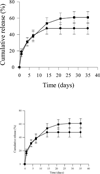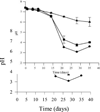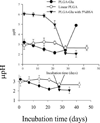Stability of proteins encapsulated in injectable and biodegradable poly(lactide-co-glycolide)-glucose millicylinders
- PMID: 18384984
- PMCID: PMC4269258
- DOI: 10.1016/j.ijpharm.2008.02.004
Stability of proteins encapsulated in injectable and biodegradable poly(lactide-co-glycolide)-glucose millicylinders
Abstract
Purpose: To characterize protein stability in poly(lactide-co-glycolide) 50/50-glucose star (PLGA-Glu) injectable millicylinders and to compare results with linear PLGA 50/50.
Methods: Bovine serum albumin (BSA), a model protein, was encapsulated in PLGA-Glu and linear PLGA millicylinders by solvent-extrusion and incubated under physiological conditions. Important system properties were characterized, including: polymer molecular weight distribution, soluble acidic residues, polymer morphology, polymer water uptake, microclimate pH, protein content and release, and protein aggregation. The polymer microclimate late in the release incubation was simulated and protein recovery was analyzed by UV280, size exclusion chromatography, amino acid analysis, and a modified Bradford assay.
Results: PLGA-Glu contained higher levels of low molecular weight oligomers, more rapidly biodegraded, and exhibited a lower microclimate pH than the linear 50/50 PLGA, which is the most acidic type in the PLGA family. BSA, when encapsulated in PLGA-Glu millicylinders, underwent extensive noncovalent insoluble aggregation over 2 weeks in vitro release, which was almost completely inhibited upon co-encapsulation of Mg(OH)2. However, by 5 weeks release for base-containing formulations, although insoluble aggregation was still suppressed, the soluble fraction of protein in the polymer was unrecoverable by the modified Bradford assay. Polymer microclimate simulations with extensive protein analysis strongly suggested that the low recovery was mostly caused by base-catalyzed hydrolysis of the oligomeric fraction of BSA.
Conclusions: In PLGA-Glu, the acidic microclimate was similarly responsible for insoluble aggregation of encapsulated BSA. BSA aggregation was inhibited in millicylinders by co-incorporation into the polymer an insoluble base, but over a shorter release interval than linear PLGA likely because of a more acidic microclimate in the star polymer.
Figures







Similar articles
-
Stabilization of proteins encapsulated in cylindrical poly(lactide-co-glycolide) implants: mechanism of stabilization by basic additives.Pharm Res. 2000 Mar;17(3):351-7. doi: 10.1023/a:1007513425337. Pharm Res. 2000. PMID: 10801225
-
Comparison of the effects of Mg(OH)2 and sucrose on the stability of bovine serum albumin encapsulated in injectable poly(D,L-lactide-co-glycolide) implants.Biomaterials. 2002 Jan;23(1):239-45. doi: 10.1016/s0142-9612(01)00101-6. Biomaterials. 2002. PMID: 11762843
-
BSA degradation under acidic conditions: a model for protein instability during release from PLGA delivery systems.J Pharm Sci. 2006 Jul;95(7):1626-39. doi: 10.1002/jps.20625. J Pharm Sci. 2006. PMID: 16729268
-
Recent advances in the stabilization of proteins encapsulated in injectable PLGA delivery systems.Crit Rev Ther Drug Carrier Syst. 2002;19(1):73-98. doi: 10.1615/critrevtherdrugcarriersyst.v19.i1.20. Crit Rev Ther Drug Carrier Syst. 2002. PMID: 12046892 Review.
-
Effect of Modifications in Poly (Lactide-co-Glycolide) (PLGA) on Drug Release and Degradation Characteristics: A Mini Review.Curr Drug Deliv. 2021;18(10):1378-1390. doi: 10.2174/1567201818666210510165938. Curr Drug Deliv. 2021. PMID: 33970845 Review.
Cited by
-
Degradable Controlled-Release Polymers and Polymeric Nanoparticles: Mechanisms of Controlling Drug Release.Chem Rev. 2016 Feb 24;116(4):2602-63. doi: 10.1021/acs.chemrev.5b00346. Epub 2016 Feb 8. Chem Rev. 2016. PMID: 26854975 Free PMC article. Review.
-
Targeted Interleukin-10 Nanotherapeutics Developed with a Microfluidic Chip Enhance Resolution of Inflammation in Advanced Atherosclerosis.ACS Nano. 2016 May 24;10(5):5280-92. doi: 10.1021/acsnano.6b01114. Epub 2016 Apr 28. ACS Nano. 2016. PMID: 27100066 Free PMC article.
-
Cell-Demanded VEGF Release via Nanocapsules Elicits Different Receptor Activation Dynamics and Enhanced Angiogenesis.Ann Biomed Eng. 2016 Jun;44(6):1983-92. doi: 10.1007/s10439-016-1581-y. Epub 2016 Mar 3. Ann Biomed Eng. 2016. PMID: 26940611 Free PMC article.
-
Minimizing acylation of peptides in PLGA microspheres.J Control Release. 2012 Aug 20;162(1):119-26. doi: 10.1016/j.jconrel.2012.04.022. Epub 2012 Apr 21. J Control Release. 2012. PMID: 22546683 Free PMC article.
-
The microclimate pH in poly(D,L-lactide-co-hydroxymethyl glycolide) microspheres during biodegradation.Biomaterials. 2012 Oct;33(30):7584-93. doi: 10.1016/j.biomaterials.2012.06.013. Epub 2012 Jul 21. Biomaterials. 2012. PMID: 22819499 Free PMC article.
References
-
- Anderson JM, Shive MS. Biodegradation and biocompatibility of PLA and PLGA microspheres. Adv. Drug Del. Rev. 1997;28:5–24. - PubMed
-
- Batycky RP, Hanes J, Langer R, Edwards DA. A theoretical model of erosion and macromolecular drug release from biodegrading microspheres. J. Pharm. Sci. 1997;86:1464–1477. - PubMed
-
- Bittner B, Witt C, Mader K, Kissel T. Degradation and protein release properties of microspheres prepared from biodegradable poly (lactide-co-glycolide) and ABA triblock copolymers: influence of buffer media on polymer erosion and bovine serum albumin release. J. Control. Rel. 1999;60:297–309. - PubMed
-
- Bodmer D, Kissel T, Traechslin E. Factors influencing the release of peptides and proteins from biodegradable parenteral depot systems. J. Control. Release. 1992;21:129–138.
-
- Bradford MM. A rapid and sensitive method for the quantitation of microgram quantities of protein utilizing the principle of protein-dye binding. Anal. Biochem. 1976;72:248–254. - PubMed
Publication types
MeSH terms
Substances
Grants and funding
LinkOut - more resources
Full Text Sources
Other Literature Sources

